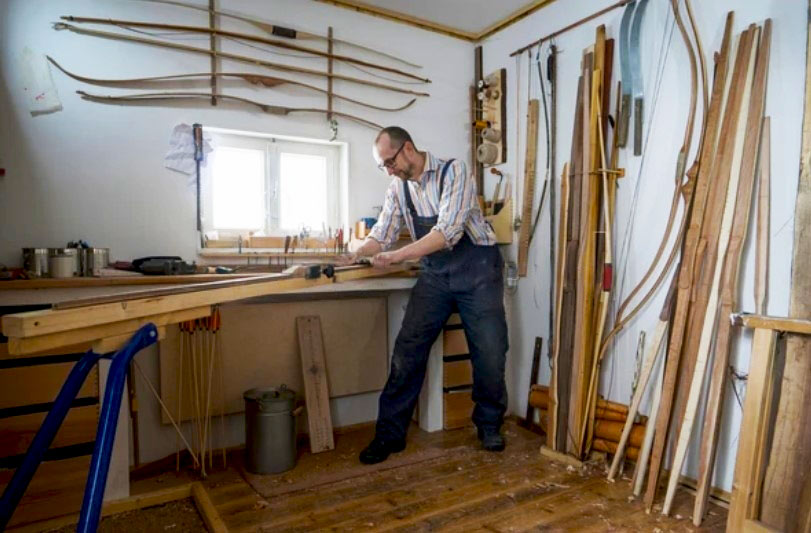Are you in the market for a new bow? With so many different types to choose from, it can be overwhelming to find the perfect one for your needs.
That’s why we’ve put together this guide to help you navigate through the options and find the best fit for you. Whether you’re into target shooting or bow hunting, we’ve got you covered.
Let’s dive into four of the most popular types of bows on the market in 2023: long bows, recurve bows, compound bows, crossbows, and those designed specifically for target shooting.
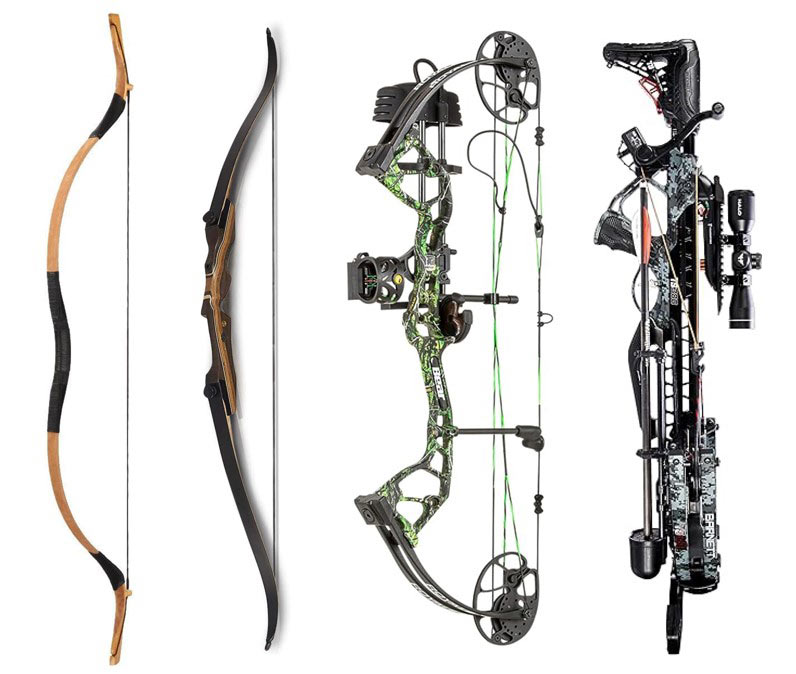
All Types of Bows: A Complete Guide to Recurve, Longbows, Compound, and Crossbows
Recurve Bows
Recurve bows are the most common and have been used for the longest time. They are called curved bows because both ends of the bow turn away from the shot when the string is pulled back.
Beginners like recurves because they are easy to use and don’t require as much strength as other types of bows.
Longbows
The longbow is more typical of traditional shooting, and it has been used all over the world since ancient times. They can be made from wood, plastic, or carbon fiber, among other things.
They don’t have any difficult features or gadgets, so you have to learn how to use them well and practice. But because they have so much power, their long draw length makes them easy to use.
Compound Bows
Compound bows have gears or cams that make it easier to shoot well than with recurves or longbows. This is because during the draw, they store energy and then quickly release it at full draw length. This keeps your hands from getting tired, so you can shoot for longer.
Most bows used for shooting today are compound bows, which are more accurate because their draw weights and lengths can be changed and they come with extras like sights, arrow rests, etc.
Crossbows
Crossbows are different from other kinds because they are made to shoot at close range with more power and accuracy than a regular bow. People often use crossbows to hunt and shoot at targets, but they can also be used for fun.
Crossbows are usually more expensive than other types of bows, but they have their own benefits, like being easier to cock and shoot because they have bigger draw weights and a longer range than other bows.
Design Features of Each Bow
Recurve Bow Design and Feature


When the string is pulled back, recurve bows have bent arms that store energy. This gives them more power than other types of bows. Beginners like them because they are easy to use and don’t weigh much.
Most of the time, wood, fiberglass, or carbon fiber are used to make the arms. Most bowstrings are made of man-made fibers like Dacron or Kevlar. Recurve bows also have a sight to help you aim and supports to keep the bow steady.
Longbows
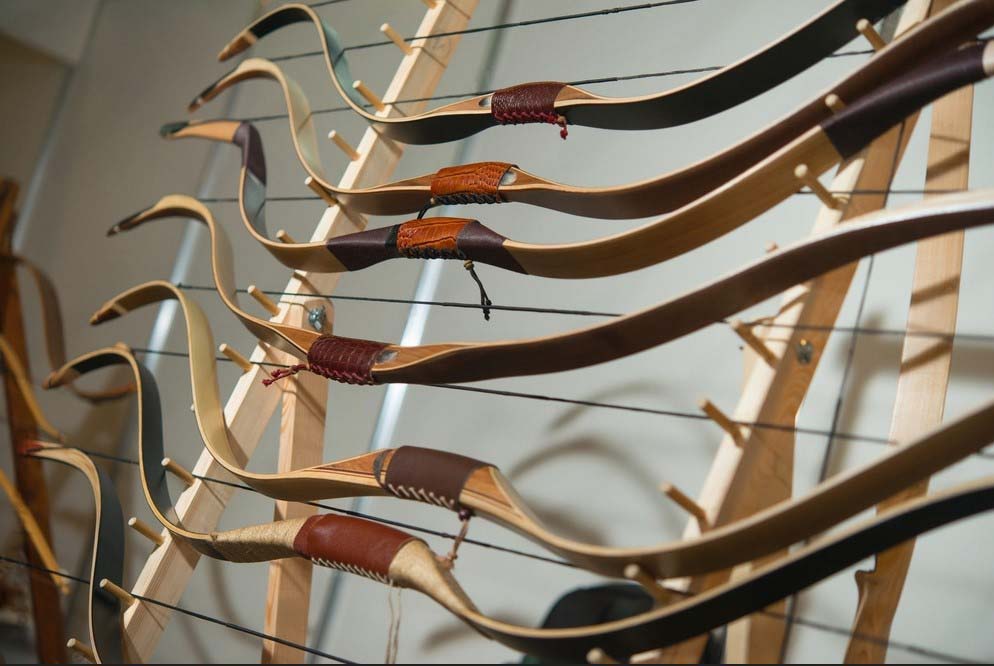

Longbows are strong and easy to shoot because they have a long draw length. Most of the time, they are made of wood, aluminum, or carbon fiber, and shooting effectively with them takes skill and practice.
Most bowstrings are made from hemp or flax, which are both natural materials. Longbows also have sights to help you aim and supports to keep them from falling over.
Compound Bows
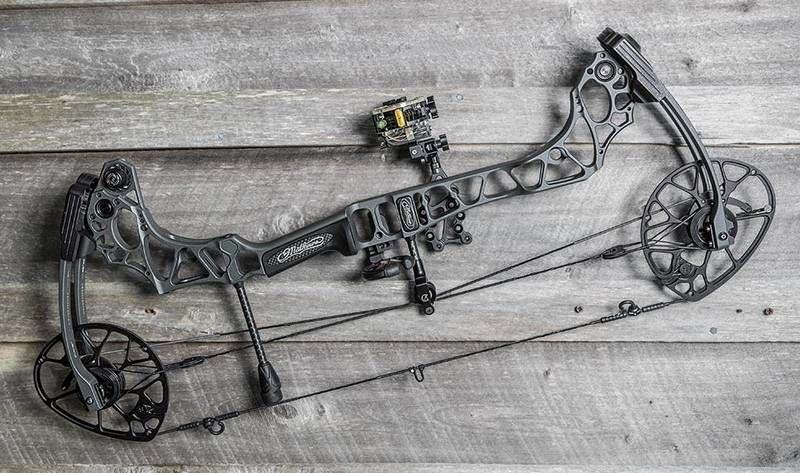

Compound bows have more power than other types of bows because they use cams and pulleys to store energy when the string is pulled back. They are larger and harder to use than recurve bows, but they hit their target more often.
The bowstring is usually made of a synthetic material like Dacron or Kevlar. The arms are usually made of metal or carbon fiber.
Compound bows also have sights to help you aim and supports to keep the bow steady. They also have a let-off, which makes it easier to hold the bow at full draw with less force.
Crossbows
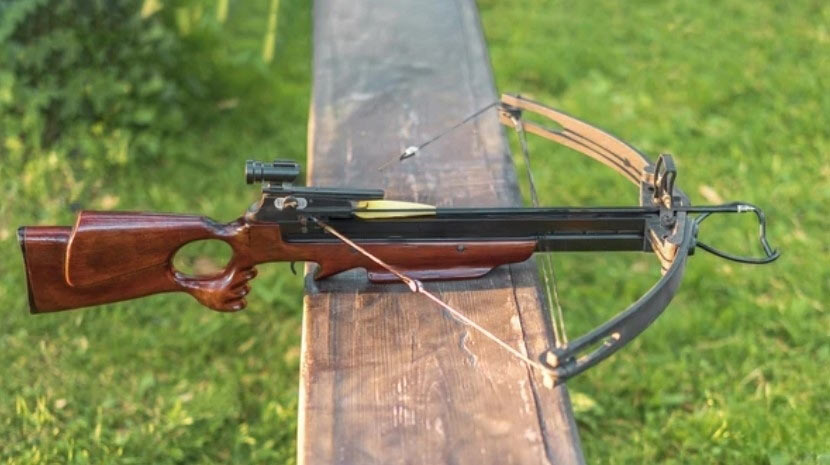

Crossbows are made to shoot at close range and have more power and accuracy than regular bows. Most of the time, they cost more, but they have their own benefits, like being faster to cock and shoot.
The bowstring is usually made of a synthetic material like Dacron or Kevlar. The arms are usually made of metal or carbon fiber. Crossbows also have a scope to help you aim and props to keep them from falling over.
Recurve Bow
The form of the recurve bow is different from that of other types. When the bow is not strung, the arms are not straight, like on a longbow. Instead, they bend away from the shooter.
This lets you shoot with more power and accuracy with less effort. The recurve bow is also lighter than other types, which makes it great for beginners or hunters who plan to move around a lot.
Limbs Curve Away From The Archer
A recurve bow is a good addition to any archer’s collection. It is a classic bow that is strong and can be used for both hunting and shooting at targets.
It’s also small and light, which makes it easy to carry and great for people who like to move around while shooting.
The recurve bow is a great choice for any shooter who wants to take their skills to the next level. It has bent limbs.
Traditional Bow Shape
A recurve bow has the shape of a standard bow. This makes it one of the easiest and lightest bows to use. Most recurve bows have a lighter draw weight, which makes them easier for people who are new to archery to use.
Also, the recurve has more power and accuracy when shooting because its limbs are bent. This gives it an advantage over other types.
Simplest And Lightest
Recurve bows are great for those who want a standard, lightweight bow. They are easy to use, have smaller draw weights, and have more power and accuracy than other types of bows.
With its bent limbs and lightweight design, the recurve bow is a great choice for any shooter who wants to take their skills to the next level.
Used for Target Shooting and Hunting
Recurve bows are used for hunting and target shooting. Recurve bows are popular for target shooting because they are effective and enjoyable.
Recurve bows provide shooters with the sensation of a bow and arrow while providing speed and precision to capture their prey. Remember that shooting restrictions vary by state and nation, so research and observe all laws.
Olympic standard bow
Archery is a sport, and the bow used in the Olympics is a recurve bow. The recurve bow is great for shooting events like the Olympics because it is small and can be used in a lot of different ways.
In Olympic archery, participants use recurve bows to shoot at fixed targets from set distances.
A recurve bow is useful for professional shooters because it is accurate and consistent. Its success has made it the standard in Olympic archery.
Longbow
The ancient art of archery has been a popular pastime for centuries. Long before they were featured in films like “The Hunger,” skilled marksmen were using bows and arrows to hunt game animals. When it comes to types of bows, one of the oldest and most popular is the longbow.
English Origin
The English created the longbow first, and they typically used it for hunting. This bow is made of yew wood, which is very flexible and can be pulled back with a lot of force to shoot arrows with great accuracy from a long distance.
And even though it looks easy, this bow can shoot strong arrows that are great for killing wild animals.
The way the longbow is shot is different from other bows. This is called “instinctive aim.” In intuitive aiming, you don’t just focus on how to aim.
Instead, you use your body’s natural senses to measure distances and choose targets. With this method, you have to move your body, look around, and use your mind to hit your goal.
Simple design
Whether you are an experienced archer or just starting out in the world of bow shooting, the longbow can be an excellent choice for a reliable hunting tool or target practice rifle.
With its traditional roots and simple design, it can also be a great way to get in touch with your inner wilderness spirit!
Pull Heavy Draw Weights
The longbow is a strong weapon that can shoot arrows at high speeds and from a distance. However, its design also allows it to pull heavy draw weights, making it a powerful choice for hunting large game.
This makes the longbow an ideal choice for hunters in search of a more traditional bow and arrow experience.
Long-range Accuracy
The longbow also offers great accuracy when shooting at longer distances. With its heavier draw weight, the longbow can easily launch arrows with enough force to reach a target up to 150 yards away.
This makes it a great choice for hunters who need to be able to shoot from afar to make sure their hunt is successful.
Instinctive-aim Shooting Technique
Another benefit of the longbow is that it helps people learn to aim by feeling. This means that you can learn to shoot without looking through a sight.
Instead, you can judge the distance and aim based on your experience. This is a fun way to improve your shooting skills while having a good time.
The longbow is a great choice for anyone who wants to start shooting or hunting with a bow and arrow in a more traditional way.
The longbow is a great hunting tool or target practice gun because it is easy to use, has big draw weights, and is accurate at long ranges. With the right skill and method, this legendary tool can give you the thrill of a good hunt.
Compound Bow
The compound bow is a type of bow that uses a system of pulleys and wires to make it easier to hold the bow at full draw with less force. This makes it easy to hold the bow still, which improves its steadiness and accuracy.
Most compound bows have a heavier draw weight than traditional bows, but the pulley system makes it easier to hold the bow at full draw with less force.
This makes it easy to take pictures for a long time. The lighter holding weight also lets you use bigger arrow weights, which can make the bow go faster and deeper.
One unique thing about a compound bow is that it has a “let-off” method that makes it easier to hold at full draw. This lets the shooter aim and hold the bow steady for longer, which makes the bow more stable and accurate.
Cam and Pulley System
The compound bow is built and made in a way that is very different from other bows. It utilizes a system of cams and pulleys that allows for greater strength and accuracy than other types of bows.
This design provides greater let-off—meaning easier draw weights—and thus increased arrow speed and accuracy.
A Compound Bow’s Arrow Speed and Accuracy
Compound bows are known for the speed and accuracy of their arrows. When a shooter uses a pulley system, he or she doesn’t have to use as much force to hold the bow at full draw.
This makes it easier for the shooter to aim and hold the bow still for longer, which improves accuracy. Also, it’s easier to hit your target if you can adjust the bow to fit your shooting style and needs.
Compound bows can shoot arrows faster than traditional bows because they have higher draw weights and can use bigger arrow weights.
The faster speed can lead to better penetration and direction, which makes them good for both hunting and shooting at targets.
Maintenance Requirements
Compared to other bows, a compound bow doesn’t need as much upkeep. If you keep the string well waxed and keep it away from high heat or wetness, it should last for many years without any problems.
But because it needs more special care than other bows, don’t be afraid to ask for help from a professional if you need to.
Benefits of Archery with a Compound Bow
The benefits of using a compound bow for archery are similar to those of archery in general, but with a few unique advantages:
Increased accuracy: A compound bow’s pulley system reduces the amount of force needed to hold the bow at full draw, making it easier to hold the bow steady and aim accurately.
Customization: Compound bows have a lot of features that can be changed, like draw length, poundage, and an arrow rest, so they can be made to fit the needs of each archer. This makes it possible to fine-tune the bow to each shooter’s style and needs, making it more precise and accurate.
Increased arrow speed: Compound bows can shoot arrows faster than traditional bows because they can use heavier arrow weights and have higher draw weights. This can give them better penetration and direction, making them useful for both hunting and shooting at targets.
Ease of use: The reduced holding weight and let-off system of a compound bow make it easier to shoot for extended periods, reducing the physical strain on the archer and improving accuracy.
The Benefits of a Compound Bow for Any Archer
Compound bows are better for shooters than other bows because they are more accurate, shoot arrows faster, and require less effort to aim.
Plus, the pulley system makes it possible to use draw weights that an archer wouldn’t be able to handle without hurting their arms or back muscles over time.
If you want to get better at shooting while still having fun, the compound bow is a great pick. There’s no doubt that this kind of bow is good for anyone who shoots.
It is well made and has a strong design that gives each shot more power and makes the bow more accurate overall.
Crossbow
There are many different kinds of bows that can be used for shooting. Each one is used and works in a different way. The crossbow is one of the bows that is used most often.
Crossbows are known for being very accurate and having a long range, which makes them a great choice for shooters and archers who want to compete. A crossbow is similar to other bows like recurves and longbows, but there are a few key differences that make it different.
One of the best things about crossbows is that they are much easier to use than traditional bows. This is because crossbows have a trigger that fires the bolt, so the user doesn’t need to be very strong or agile. Crossbows can also be given a scope, which makes it easier to shoot correctly.
Crossbows can be very accurate and strong, with arrows that move quickly and hit their targets with a lot of kinetic energy. But they are heavier and bigger than traditional bows, which makes them less good for shooting on the move or moving around.
Draw Weight
The draw weight is the first thing that makes a crossbow different. A standard bow can have a draw weight of more than 50 pounds, but a crossbow can have up to 150 pounds of power. This means that users don’t have to work as hard to pull back, and each shot has more power.
Design
Crossbows are different from standard bows in how they are made. They don’t have a single bent limb; instead, they have two arms that are straight and connected by a stock.
This design gives the shooter more power and accuracy because they can aim down the sight and fire with more accuracy.
The bowstring is usually made of a synthetic material like Dacron or Kevlar. The arms are usually made of metal or carbon fiber.
Safety
Another key feature of crossbows is their safety features. Most modern crossbows have an automatic safety system that keeps the bow from firing when it is cocked and an anti-dry fire system that keeps the bow from firing when there is no arrow loaded.
This makes them much safer than traditional bows, which can be dangerous if handled incorrectly.
Mechanical Release
Another key factor that sets the crossbow apart from other types of bows is its mechanical release. Crossbows do not require users to use their fingers to manually shoot each arrow; instead, they have triggers that allow users to fire an arrow without having to draw back the string each time. This makes it much easier and more accurate than other types of bows.
How Accurate and How Far
The last thing that makes the crossbow unique is how accurately and far it can shoot. Crossbows can shoot darts farther and more accurately than other types of bows. This makes them great for hunts or shooting events at long distances.
Also, because they don’t take as much effort as other bows, they are great for people who are new to archery or who have trouble keeping traditional bows steady while shooting at targets that are farther away.
Uses and Benefits of a Crossbow
The crossbow can be used for both hunting and shooting at targets. It is strong enough to kill big game and sharp enough to shoot with precision. A crossbow’s draw weight is generally higher than that of a regular bow, which can help those who want more power and accuracy.
The crossbow is also easy to use and can be fired quickly, which makes it perfect for hunters who need to shoot fast.
The crossbow is also good for shooting at targets because it is more precise than a regular bow.
Choosing the Right Bow for Your Needs
Choosing the right bow for you depends on a number of things, such as your level of experience, how you plan to use it, and your own preferences. Here are some key considerations when selecting a bow:
Recurve Bow: If you are new to archery or prefer a lighter bow, the recurve bow may be the best choice for you. They are simple in design, lightweight, and have a lower draw weight, making them easier for beginners to handle. Additionally, recurve bows are a popular choice for target shooting and hunting.
Longbow: If you prefer a more traditional bow, the longbow may be the best choice for you. They are simple in design and have a high draw weight, making them best suited for experienced archers. People also like to hunt with longbows, which are accurate at longer distances.
Compound Bow: If you want a highly accurate and customizable bow, the compound bow may be the best choice for you. They are more complex than other types of bows and offer a range of adjustable features that allow you to customize your shooting experience. Also, compound bows can shoot arrows at high speeds and are a popular choice for shooting at targets.
Crossbow: If you want a bow that is easy to use and offers increased accuracy, the crossbow may be the best choice for you. They are heavier and bulkier than other types of bows but are ideal for stationary hunting or target shooting. Crossbows also have a trigger that lets the bolt go, which makes them easy for archers of all skill levels to use.
Benefits of Each Type of Bow
Each type of bow has its own unique benefits, depending on the archer’s needs and preferences. Here are some of the benefits of each type of bow:
Recurve Bow:
- lightweight and easy to handle, making them ideal for beginners.
- lower draw weight, making them easier to use.
- versatile, suitable for both target shooting and hunting.
- Simple design and low maintenance.
Longbow:
- Traditional design and materials are ideal for experienced archers.
- high draw weight, making them suitable for hunting.
- good accuracy at longer ranges.
- requires good form and technique for effective use.
Compound Bow:
- highly accurate, with a range of adjustable features for customization.
- capable of generating high arrow speeds.
- Ideal for target shooting and hunting.
- more complex design, requiring more maintenance and expertise to use effectively.
Crossbow:
- easy to use, with a trigger mechanism for increased accuracy.
- This model is ideal for stationary hunting or target shooting.
- heavier and bulkier than other types of bows.
- Suitable for archers of all skill levels.
It is important to consider your own needs and preferences when choosing a bow, as each type has its own unique benefits.
Before you buy a bow, you should talk to an experienced archer or a professional. They can help you figure out which type of bow is best for your needs.
What’s Best for Beginner Archers?
For beginner archers, the best type of bow is typically a recurve bow. This is because recurve bows have several key benefits that make them ideal for beginner archers:
Lower draw weight: Recurve bows typically have a lower draw weight, making them easier to use and more suitable for those who are just starting out.
Lightweight: Recurve bows are typically lightweight and easy to handle, making them ideal for those who are new to the sport.
Simple design: Recurve bows have a simple design, making them easy to set up and maintain. This makes them an ideal choice for those who are new to archery.
Versatility: Recurve bows can be used for both hunting and shooting at targets, which makes them a good choice for people just starting out with archery.
Beginners should also take a class to learn the basics of archery or get lessons from a qualified archery coach. This will make sure you get the right advice and instructions about safety, technique, and how to use the equipment.
Tips For Selecting The Right Bow and Arrow Upgrades
There are a few important things to think about when choosing the right bow and arrow upgrades. Here are some tips to help you make the best choice for your needs:
Purpose: Consider why you want to start archery, whether it be for target shooting, hunting, or recreational use. The type of bow and upgrades you choose will depend on your intended use.
Skill level: Consider your skill level as well as any goals you have for your archery. Different bows and upgrades will be better suited for different levels of experience and skill.
Physical attributes: Consider your physical attributes, such as height, weight, and strength. This will help determine the draw weight and draw length that are appropriate for you.
Budget: Consider your budget, as different bows and upgrades can vary greatly in price. It is important to make sure you invest in quality equipment that meets your needs while also fitting within your budget.
Upgrade options: Consider what upgrades you may want or need, such as sights, stabilizers, or arrow rests. Some bows come with basic upgrades included, while others may require additional purchases.
Local archery store: You might want to go to a local archery store, where you can try out different bows and talk to experienced archers for advice. This can help you make an informed decision on the right bow and upgrades for your needs.
What is The Difference Between a Long Bow and a Recurve Bow?
Let’s start with the long bow. Long bows are traditional bows with long, straight limbs that curve away from the shooter when not strung.
It’s easy and doesn’t need sophisticated components or tools. Long bows are stylish and historic. They typically evoke Robin Hood and the Middle Ages.
The recurve bow bends rearward. Even when pulled, recurve bow limbs face away from the shooter, unlike long bows. Bent limbs store more energy than straight limbs in a long bow when drawn.
This strengthens the shot over a long bow. The limbs’ rearward curvature gives them the term “recurve”.
Recurve bows are versatile, which is great. It is tiny and powerful, making it popular in contemporary target shooting and Olympic events. Stabilizers, sights, and clickers improve recurve bow accuracy and consistency.
So there! Long bows and recurve bows vary mostly in construction, power, versatility, and usage. No matter which bow you select, practice regularly, consider archery a sport, and enjoy your 2023 archery adventures!
What Type of Bow is Best for a Beginner Archer?
Want to learn arrow shooting? Oh, terrific! My buddy, welcome aboard. Now, the million-dollar question: what bow is ideal for a beginning archer?
Good news—you have many terrific options. Recurve and compound bows are most popular with beginners. Each has perks, so choose what you enjoy most. Break it down?
Recurve bows are basic, trustworthy, and easy to use, so many start with them. The term stems from their bent form. These bows are perfect for hunting and target shooting. Recurves help shooters gain form and proficiency. They also won’t break the bank, which is great for beginners.
If you enjoy modern technology and want greater power, a compound bow may be suitable for you. Pulleys and wires make compound bows simpler to draw and keep fully drawn.
This makes your muscles work less, which is wonderful for novices building strength. Compound bows are typical for hunting, but they may also be used for target shooting.
How Do You Choose The Right Type of Bow for You?
If you are new to archery or bow shooting, it may be hard to choose a bow. To find the right bow for your needs and tastes, you have to do some research and try different ones. Here are some places to start:
1. Figure out what you want to do: The first step in choosing a bow is to know what you want to do. Do you like to shoot at targets, go bow hunting, or use a standard bow? If you know what you want to use the bow for, that can help you decide.
2. Strength and experience: The bow you choose will depend mostly on how strong you are and how much experience you have. For people who are just starting out or don’t have much upper body strength, a compound bow with a draw weight and let-off that can be changed may be best. If you are skilled and strong enough, shooting with a recurve bow is more traditional and harder.
3. Try out different bows before you buy one. The best way to choose a bow is to try out different types. Go to an archery shop or range where you can rent or try out gear. This lets you test the weight, draw length, and comfort of different bows. You can decide what works when you try out bows in person.
4. Talk to pros: If you’re still not sure about a bow, talk to experts. Ask shooters or bow hunters with lots of knowledge about their bows. Their understanding could give you important ideas and thoughts. Ask the staff at an archery store or range for tips and help making a choice.
Conclusion
Archery is a fun and interesting sport that can help you get better at focusing and coordinating your hands and eyes. To start, you need to pick the right bow and upgrades for your needs. There are four main types of bows: the recurve, the longbow, the compound, and the crossbow.
Each type has its own advantages and disadvantages. For a new shooter, a recurve bow is generally the best choice because it is easy to use, has a low draw weight, and is light. Think about why you want to shoot darts, how skilled you are, how you look, how much money you have, and what kinds of upgrades are available when picking a bow and improvements.
Bow Types FAQ: Your Comprehensive Guide to Archery Options
What is the difference between a recurve bow and a compound bow?
Explain the key distinctions between these two popular types of bows.
Are longbows and traditional bows the same thing?
Clarify whether these terms can be used interchangeably or if there are differences.
Which type of bow is best for beginners?
Offer recommendations for individuals new to archery and explain why a certain type may be more suitable for beginners.
What are the advantages of a compound bow over other types?
Discuss the unique features and benefits that make compound bows stand out.
Can you use different types of bows for different purposes, like hunting or target shooting?
Explain how the choice of bow can vary based on the intended use.
What are takedown bows, and why are they popular among archers?
Describe what takedown bows are and the advantages they offer in terms of portability and customization.
Are there specific bows recommended for children or youth archers?
Provide information on bows designed for younger archers and safety considerations.
What accessories or equipment do I need to complement my choice of bow?
Discuss essential accessories such as arrows, sights, stabilizers, and quivers that are commonly used with different types of bows.
How do I choose the right draw weight and draw length for my bow?
Offer guidance on determining the appropriate specifications for your bow based on your individual strength and physique.
Can you customize bows to fit personal preferences or aesthetics?
Explain whether bows can be personalized in terms of color, design, and other features.
Are there any traditional or historical bows worth exploring for enthusiasts?
Share information about traditional or historical bows that may interest archery enthusiasts looking for a unique experience.
What maintenance is required for different types of bows?
Provide tips on how to care for and maintain various types of bows to ensure their longevity and performance.
Where can I purchase different types of bows and related equipment?
Suggest reputable sources or stores where readers can find the bows and accessories you’ve discussed.
Are there any safety considerations when using different types of bows?
Highlight safety precautions and best practices for using each type of bow to avoid accidents or injuries.


